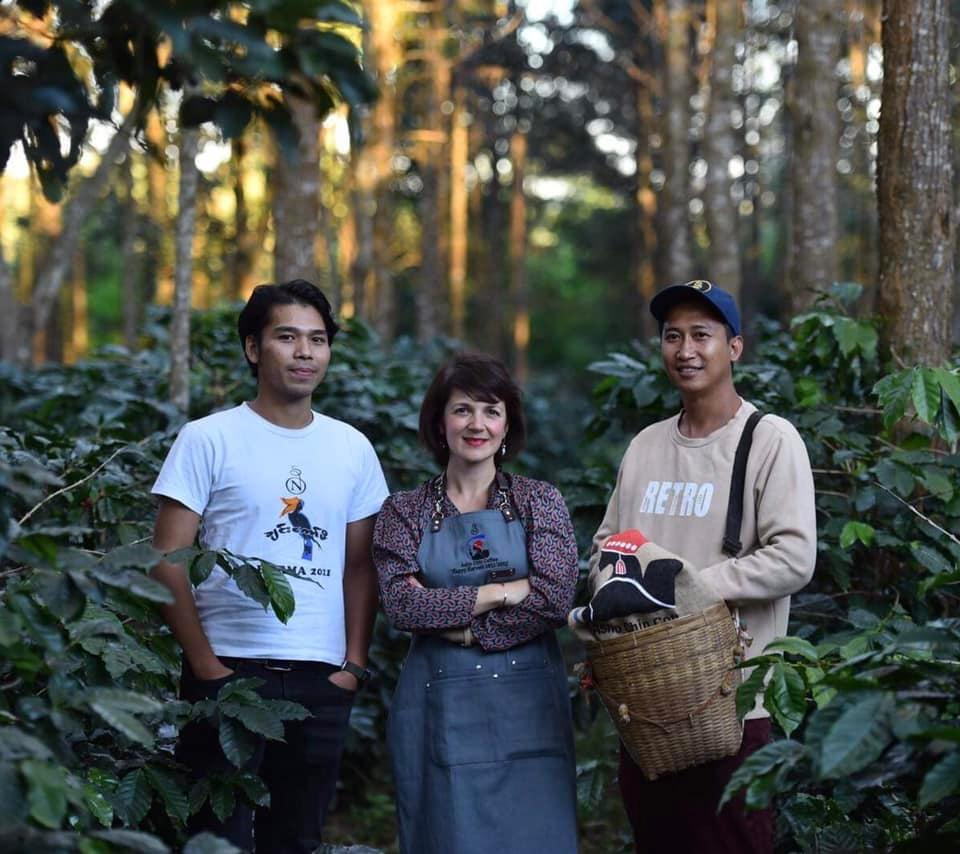Myanmar
Did you know?
The Republic of the Union of Myanmar, formerly known as Burma, is the largest country in mainland Southeast Asia. It is located between Thailand, China, India and Bangladesh. After its independence in 1948, the country was considered rich and promising. But after many decades of political troubles, its population of over 52 million people lives today in one of the poorest countries in the world.
The country has 2.000 kilometers of coastline, which goes from the Bay of Bengal to the Andaman Sea. The mountainous regions in the north have a subtropical climate ideal to the production of fine Arabicas. The flat hot and humid southern regions produces Robustas. The majority of the country is located between the Tropic of Cancer and Equator, lying in the monsoon region of Southeast Asia.
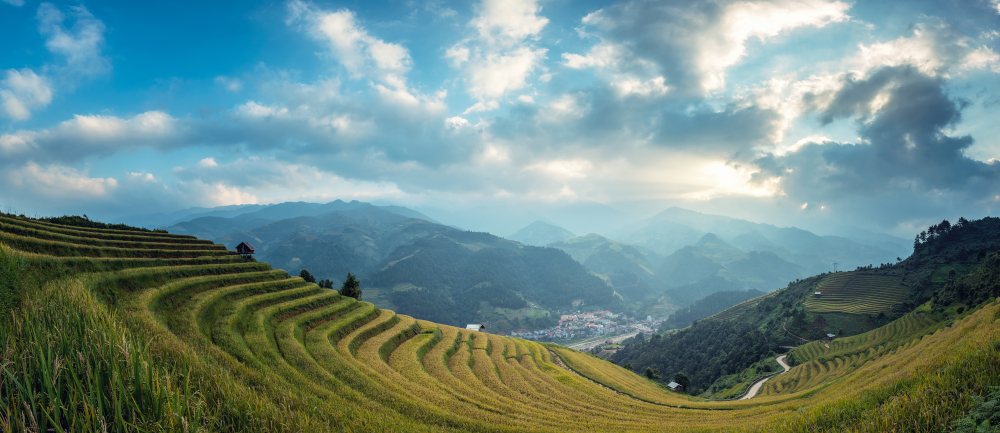
Fair Wild Coffee
Chin Litäi Coffee is the first coffee to be certified Fair Wild.
Chin coffee grows in the North West of Myanmar and in Chin Highlands, including coffee spots in Tonzang, Teddim, Falam, Mindat, Kanpelet and Matupi. The 50 Chin Litäi coffee producers cultivate some of the finest coffee in Myanmar. The young cooperative was founded in December 2016. Most of the producers are younger than 35 years. They are committed to grow high quality coffee to mitigate deforestration.
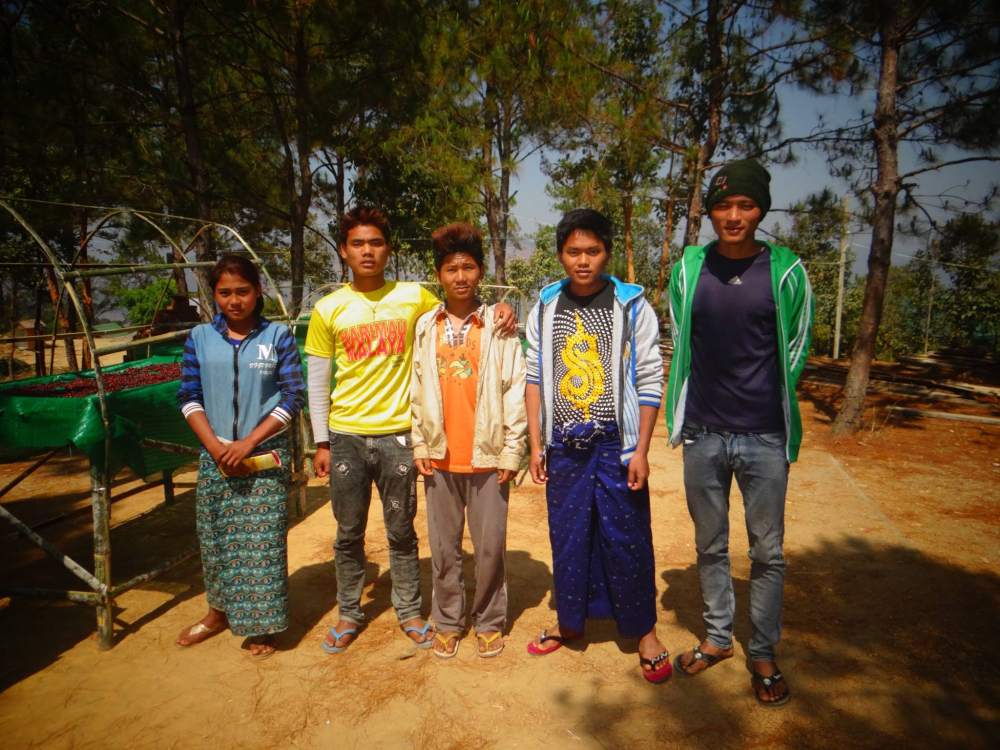
About Fairwild
FairWild certification is a set of standards that ensures the sustainable and fair sourcing of wild plant ingredients. It is a non-profit organization that was founded in 2008 by a group of conservationists, businesses, and scientists. The FairWild Standard covers the entire supply chain, from the collection of wild plants to the processing and marketing of the finished products.
The FairWild Standard has three main pillars:

- Biodiversity conservation: The standard ensures that wild plant resources are harvested sustainably and that the ecosystems in which they grow are protected.
- Fairness and equity: The standard ensures that wild plant collectors are treated fairly and that they receive a fair share of the profits from the sale of wild plant ingredients.
- Traceability and transparency: The standard ensures that the origin of wild plant ingredients can be traced back to the wild collection site.
There are currently over 78 companies that are FairWild certified, and the number is growing all the time. These companies include harvesters, processors, retailers, and brands. FairWild-certified products can be found in over 50 countries around the world.
If you are looking for a product that has been sustainably and fairly sourced, look for the FairWild logo. The FairWild logo is a guarantee that the product has met the high standards of the FairWild Standard.
Here are some of the benefits of FairWild certification:
- It helps to conserve biodiversity.
- It ensures fair treatment of wild plant collectors.
- It provides traceability and transparency.
- It gives consumers the power to choose products that are aligned with their values.
If you are interested in learning more about FairWild certification, you can visit the FairWild website.
Coffee facts
Crop periods
Flowering Period |
|
Main : April until May |
Harvesting Period |
|
Main : December until March |
- Mandalay region (1100 meters sea-level average) starts in November
- Shan State (1250 meters sea-level average) – the biggest coffee producing state is harvesting from end of December
- Chin State (1500 meters sea-level average) – the highest situated coffee producing state starts harvesting mid of January
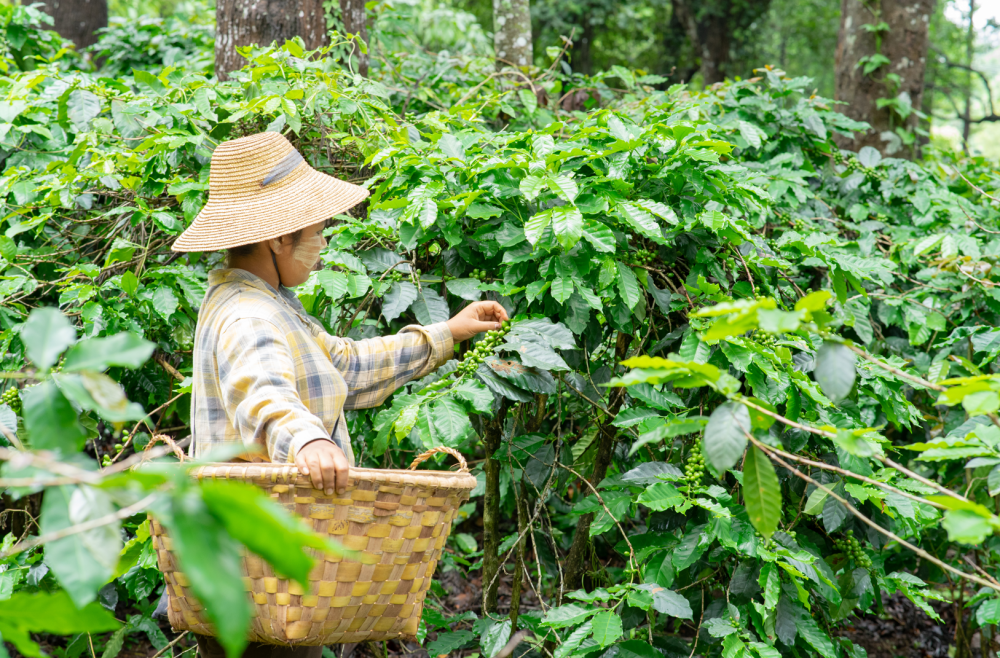
Shipping Period |
|
Main : May until June |
|
Secondary : September until October |
|
Port of Shipment |
Imp. |
EU |
US |
|
Yangon |
100% | 30 days |
90-120 days |
The Port of Yangon is the largest port in Myanmar and one of the busiest ports in Southeast Asia.
- It is located on the Yangon River, near the Gulf of Martaban.
- The port handles a wide variety of cargo, including containers, bulk commodities, and oil.
- The port is also a major hub for passenger traffic.
- The Port of Yangon is operated by the Myanmar Ports Authority.
The port has two main harbor areas:
-
Yangon Inner Harbour
-
The Thilawa Outer Harbour is the newer of the two harbors and is located about 16 kilometers south of the city
Countries of Export
There are no official numbers related to the export destinations.
According to “The Global Light” Myanmar exports to 14 importer countries.
- China (3000-4000 metric tons per year – unregistered trade)
- Japan and Korea
- US
- Europe
Nice to know
Arabica coffee is mostly grown in the highlands, Robusta coffee is grown in the lowlands
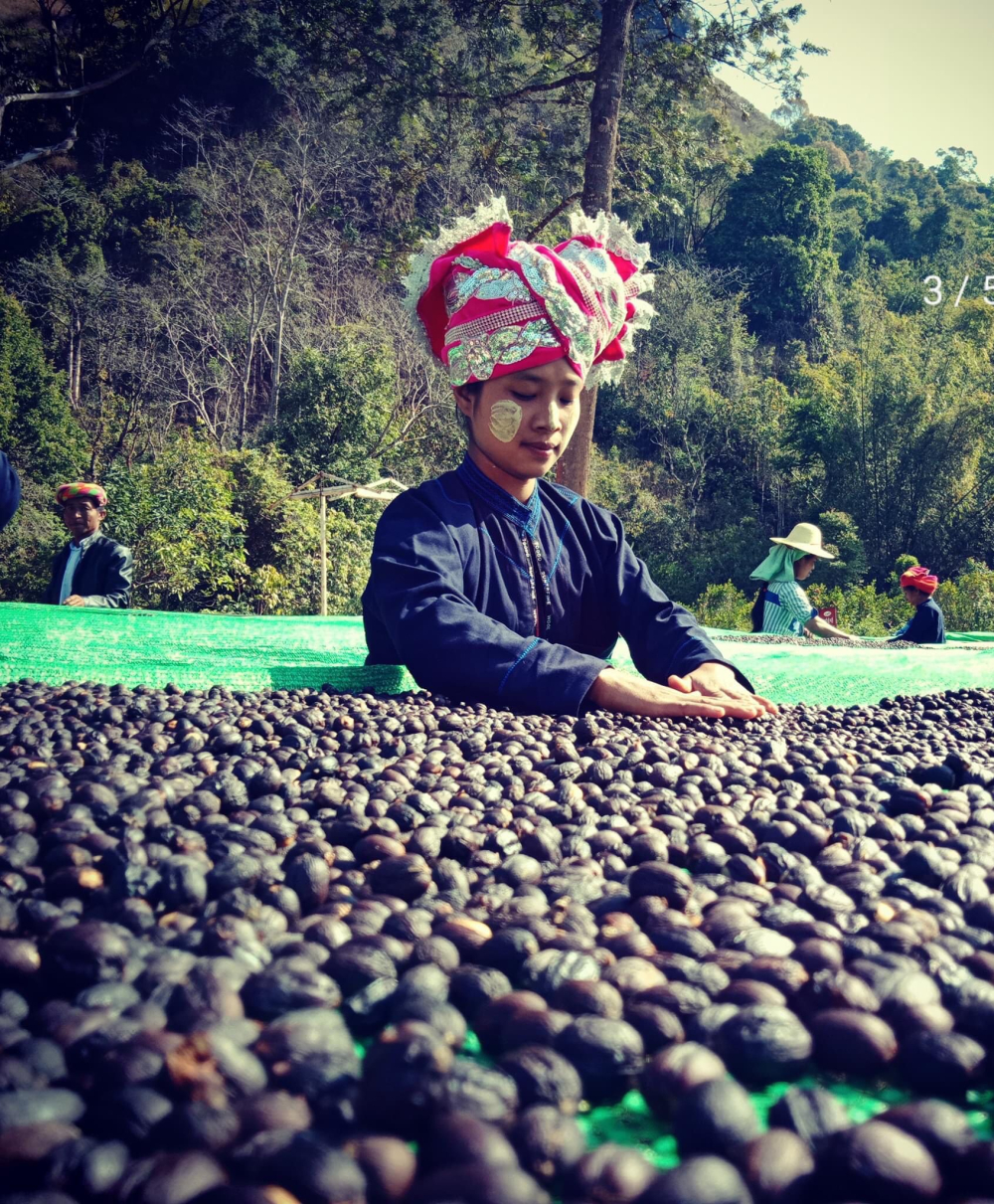
Classifications
Varieties
Today, around 80 percent of all coffee grown in Myanmar is Arabica; Robusta is mostly grown in the lowlands, while Arabica is grown at higher altitudes.
In 1970-er FAO introduced Catimor (H528) to Myanmar and expanded over all 7 coffee regions (Mandalay, Shan State, Magway Division, Chin State, Sagaing, Kachin, Kayin).
In the 1990 – with the privatisation of the coffee sector – new varieties such as Catuai, Caturra and Bourbon were introduced. Common varietals grown include Caturra, Catimor, Bourbon, Typica, S795, and SL34. The harvest is meticulously picked, processed, and sorted and collected on a village level, then either sent to a central mill for processing, or sun-dried on raised beds.
By Region
There are 7 coffee regions in Myanmar. The main producing region is Shan State (3000-4000 metric tons), followed Mandalay Division and Chin State. There are 50.000 acres of coffee per 2021. The extension grew from 35’000 acres in 2012 to 50.000 acres, with major extension in Shan State. The coffee farmers are experimenting with new varietals such as geisha or yellow bourbon.
By Grade
Myanmar aligns with SCA standards
By Screensize
There is no normative screen size in Myanmar. For export “screen 15+” is required.
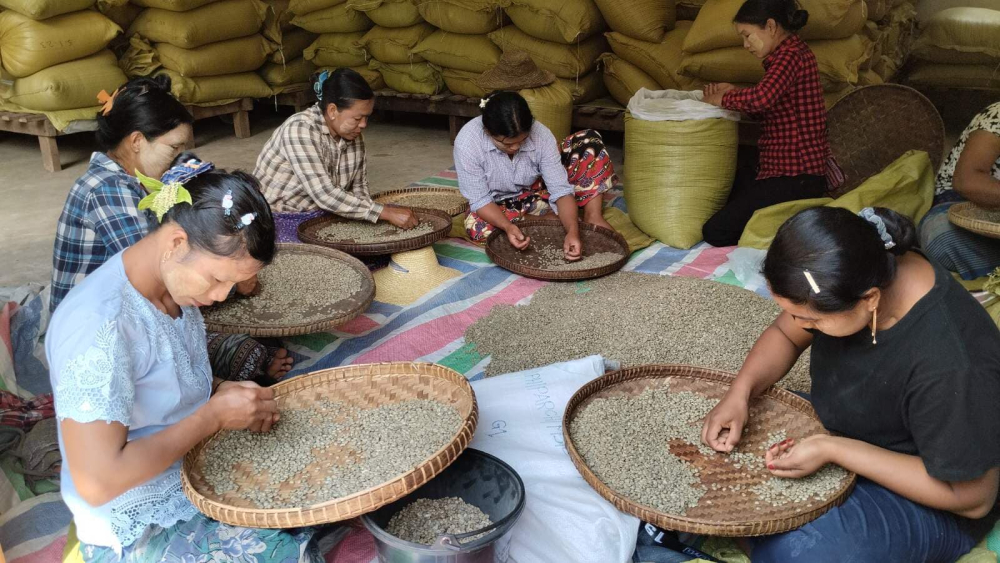
Cup Profile
We can differentiate cup profiles depending to the terroir and the varieties. 3 profiles can roughly be differentiated:
- Mandalay division: nutty, chocolate, lime, vegetal, strawberry
- Shan State: fruity, orange, lemon, sparkling, tea-like
- Chin State: spicey, winey, muscat, nutty
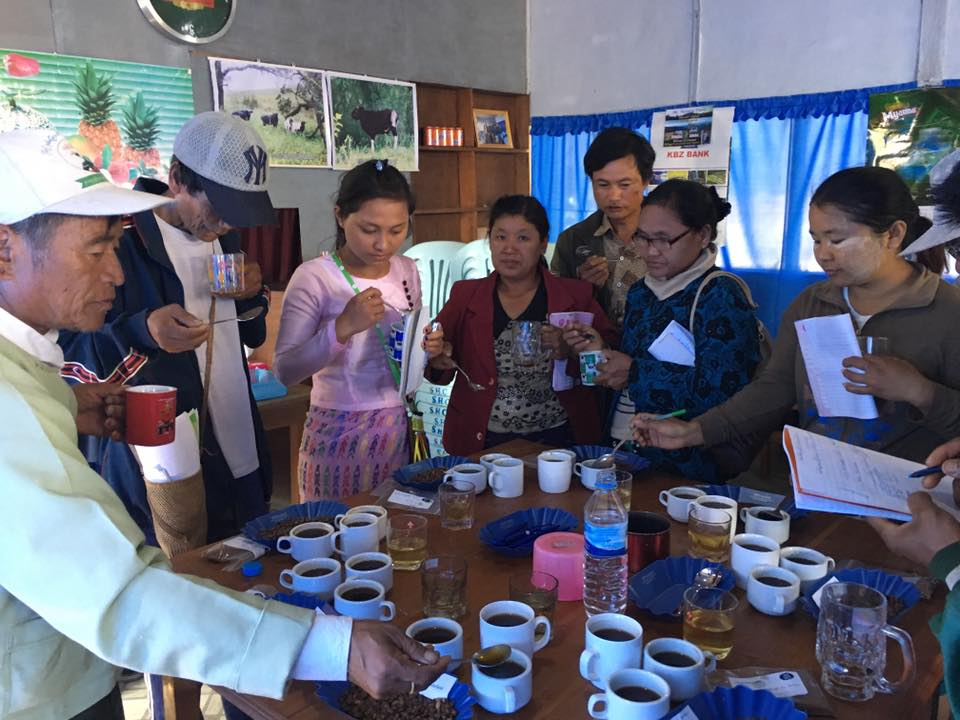
Moisture
For export quality: 9-12 %
Typical Description
Maymyo Coffee, Estate Coffee
- Washed
- SL34, S795, Catimor
- Screen > 15, Grade 1
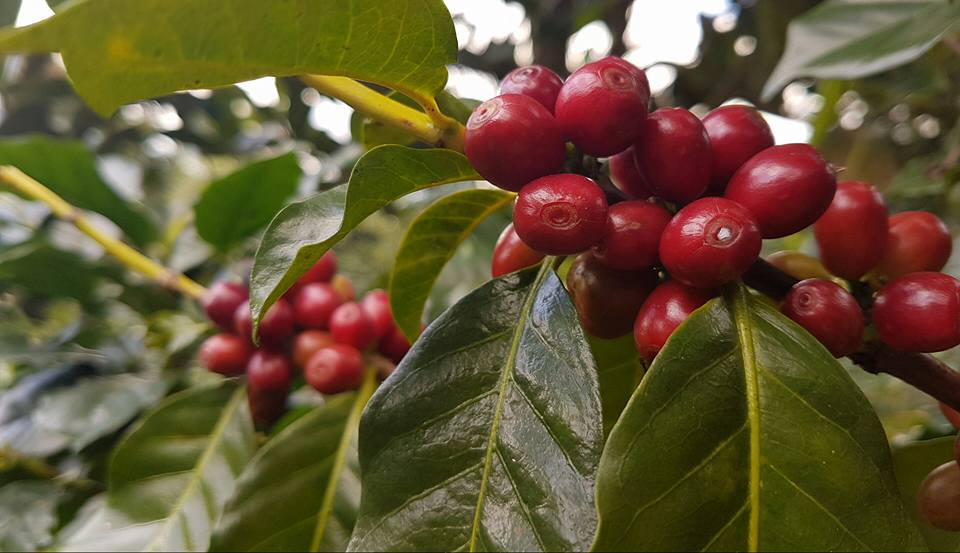
Processing
In Myanmar, there are three types of processing:
- Washed
- Natural dried (sun-dried)
- Honey-processed
In Shan and Chin State, producers are gathering in cooperatives and process at a central mill (For Shan: Amara Group, Danu Nay La, Shwe Ywar Ngan, Danumal, Shwe Taung Tu; for Chin: Nat Coffee, Hornbill).
In contrast, Mandalay region is known as the region with coffee estates. The largest coffee estate is 400 acres. The coffee is being picked and processed in the estate itself.
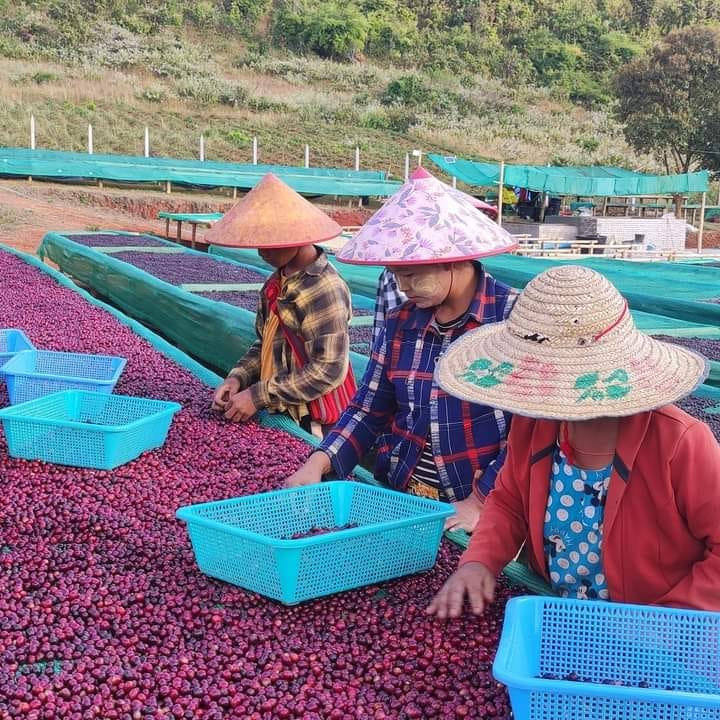
Coffee Environment
Production
Myanmar is mainly known for its specialty coffee production.
In 2015, when Myanmar opened to the markets after 60 years of political and economical isolation, development agencies and private sector partners invested into the revitalization of the coffee sector by demanding high quality coffee.
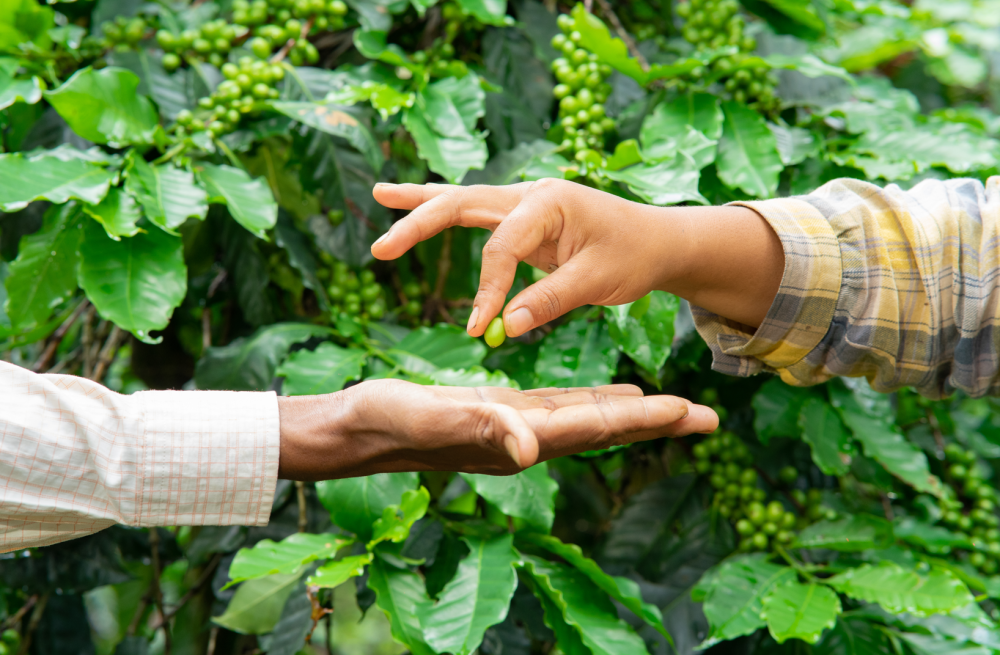
Official Bodies
Myanmar Coffee Association was established in 2014 by USAID/Winrock with the aim to increase income for coffee farmers and to upgrade their living quality by means of annual increase in productivity and innovation.
Their main office is located in Pyin Oo Lwin City (formerly Maymyo), a scenic hill town in Mandalay division, Myanmar.
There is no MCA office, nor physical presence.
Exporters
|
Mandalay Coffee Group |
|
|
Amara Group |
|
|
Sithar |
|
|
Nat Coffee |
From Opium to Coffee?
Myanmar was the second-largest producer of opium in the world. Opium use has historically been medicinal or traditional, with people offering it at ceremonies such as weddings. However, more serious drug-related issues have arisen. There are now many cases of HIV/AIDs and hepatitis C. This is due to the general switch to the more cost-effective manner of injecting heroin rather than smoking it, resulting in the unsanitary sharing of needles.
There are a number of reasons why coffee is seen as a more sustainable and viable option for farmers in Myanmar :
- coffee is less labor-intensive than opium cultivation, which means that farmers can produce more coffee with less work.
- coffee is a more stable crop, as it is not as susceptible to weather fluctuations as opium poppies.
- coffee is a more valuable crop, as it can be sold for a higher price on the international market.
There have been a number of initiatives to help farmers in opium-producing areas transition to coffee cultivation, and some of these initiatives have been successful in reducing opium cultivation and increasing coffee production.
For example, the United Nations Office on Drugs and Crime (UNODC) has been working with farmers in the Shan State of Myanmar to help them switch to coffee production. The UNODC has provided farmers with training on coffee cultivation and processing, as well as access to markets for their coffee. As a result of this project, over 1,000 farmers in the Shan State have switched to coffee production, and the amount of opium produced in the region has decreased.
However, there are still challenges to the switch from opium to coffee.
- One challenge is that coffee production takes more time and effort than opium cultivation. Opium poppies can be harvested once a year, while coffee trees take several years to mature and can only be harvested once a year. This means that farmers who switch to coffee production may have to wait several years before they see a profit.
- Another challenge is that coffee prices are volatile. The price of coffee can fluctuate significantly from year to year, which makes it difficult for farmers to plan their finances. This is especially true for farmers who are new to coffee production and do not have a lot of experience in the market.
Here are some additional thoughts on the switch from opium to coffee in Myanmar:
- The success of the switch will depend on a number of factors, including the availability of technical assistance and training for farmers, the development of sustainable coffee production practices, and the establishment of fair and stable coffee markets.
- The switch from opium to coffee could have a number of positive impacts, including:
- Reduced opium cultivation and drug trafficking
- Increased income and livelihood opportunities for farmers
- Improved food security and nutrition
- Reduced environmental degradation
- The switch from opium to coffee will also require addressing the underlying causes of opium cultivation, such as poverty, lack of economic opportunities, and political instability.
Overall, the switch from opium to coffee in Myanmar is a complex and challenging undertaking. However, it has the potential to be a successful way to reduce opium cultivation and drug trafficking, improve the lives of farmers, and protect the environment.
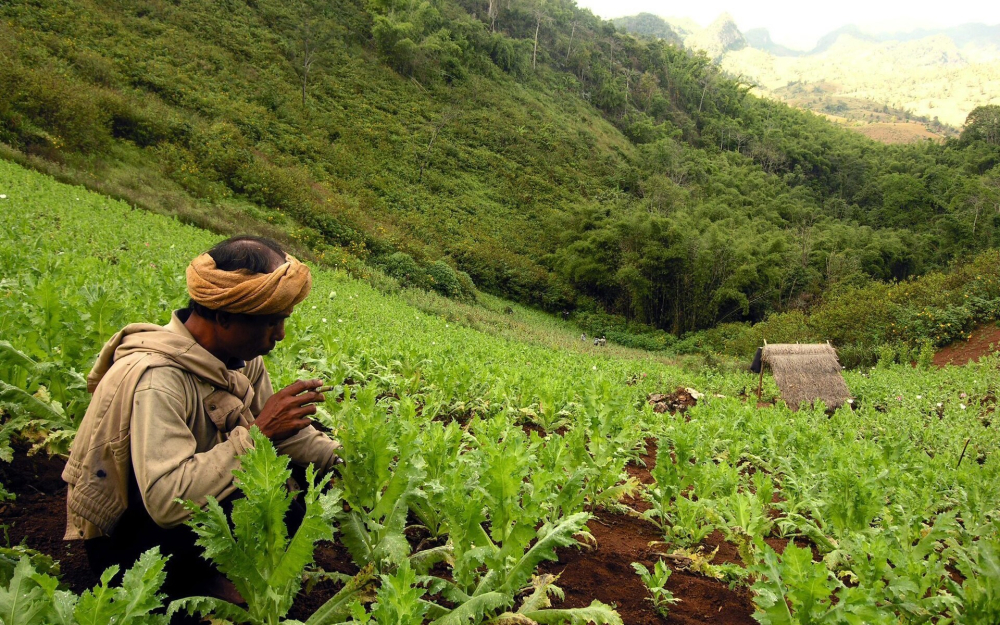
With special thanks
for her contribution to Nathalie F. Manac'h, CEO and Founder of Nat Cof Ltd.
